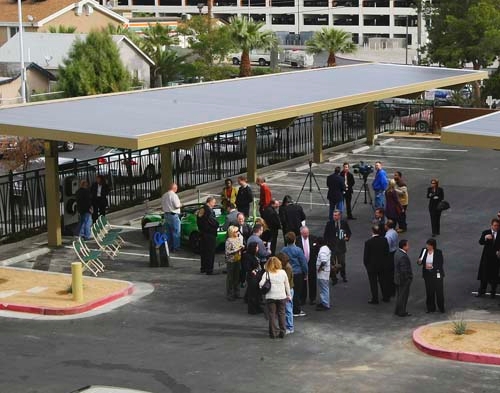City dedicates first of three solar carports


Las Vegas officials dedicated the first of three planned solar panel carports Thursday, but patriotism almost got the event canceled before it started.
Mayor Oscar Goodman noted that a sample solar module on display was assembled in Mexico.
"When I saw that, I went nuts," he said. "I felt that that was totally unacceptable as far as our sustainability efforts in the United States."
City officials assured him, though, that the panels actually installed on the carports at the Stupak Community Center near the Stratosphere were made and assembled in the United States.
Funding for the project came from a stimulus bill grant from the Department of Housing and Urban Development, which requires elements of a project to come from domestic sources.
"They promised me that it’s all made, assembled here," said Goodman, whose final mayor term wraps up in June. "I’ll take them at their word. If I find out differently, I’ll personally go up there and rip them off."
The solar electric modules came from Uni-Solar, a company headquartered in Rochester Hills, Mich., and that’s where the modules were made, city spokesman David Riggleman said. Steel and electric equipment also was made in the United States, said Tom Perrigo, the city’s chief sustainability officer.
"We watch it very carefully," he said.
The carports at the Stupak Center will generate about 50,000 kilowatt-hours annually, or roughly 30 percent of the building’s electricity use, Perrigo said.
Also installed at the center is a station for recharging electric cars. It initially will be available to the public, since the charging requirements are tiny compared to the energy generated by the solar panels, and city officials want to gauge demand for the stations.
Two more solar carports are planned at the Las Vegas Natural History Museum and Fire Station No. 10 on Martin Luther King Boulevard.
They are being paid for with the $1.2 million HUD grant and a $414,250 rebate check from NV Energy. The overall budget will be about $1.3 million, and the surplus will be put toward other solar projects, Perrigo said.
The three projects will cut energy costs by about $28,000 annually, according to the city. Solar panels have an expected useful life of about 30 years.
Las Vegas’ broader solar plan calls for 1.8 megawatts of solar power to be generated at various city facilities, enough power for about 260 homes.
In 2008, the average U.S. residential customer used 11,040 kilowatt-hours in a year, according to the Department of Energy.
Contact reporter Alan Choate at achoate@reviewjournal.com or 702-229-6435.












